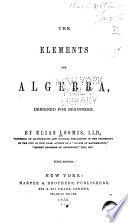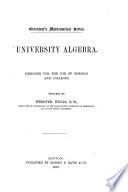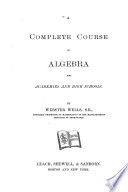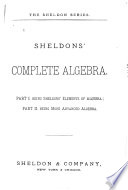 | Elias Loomis - Algebra - 1856 - 280 pages
...terms the exponent of a diminishes by unity until we reach the last term which does not contain a. The exponent of b in the second term is 1, and increases by unity in each term to the right, until we reach the last term in which the exponent is the same as... | |
 | William Guy Peck - Algebra - 1875 - 348 pages
...right to the 'last term, where it is equal to the exponent of the power. 2°. LAW OF COEFFICIENTS. — The coefficient of the first term is 1 ; the coefficient of any succeeding term is found by multiplying the coefficient of the preceding term by the exponent of the... | |
 | Webster Wells - Algebra - 1879 - 468 pages
...exponent of a in the first term is 6, and decreases by 1 in each succeeding term. The exponent of x in the second term is 1, and increases by 1 in each succeeding term. The coefficient of the first term is 1 ; of the second term, 6 ; if the coefficient of the second term,... | |
 | Webster Wells - Algebra - 1885 - 382 pages
...less by 1 than the exponent of a in the dividend, and decreases by 1 in each succeeding term. Ш. The exponent of b in the second term is 1, and increases by 1 in each succeeding term. IV. The terms are all positive when the divisor is a — b, and are alternately positive and negative... | |
 | Webster Wells - 1885 - 368 pages
...term is the same as the exponent of the binomial, and decreases by 1 in each succeeding term. III. The exponent of b in the second term is 1, and increases by 1 in each succeeding term. IV. The coefficient of the first term is 1 ; and of the second term, is the exponent of the binomial.... | |
 | Webster Wells - Algebra - 1885 - 370 pages
...less by 1 than the exponent of a in the dividend, and decreases by 1 in each succeeding term. III. The exponent of b in the second term is 1 , and increases by 1 in each succeeding term. IV. The terms are all positive when the divisor is a — b, and are alternately positive and negative... | |
 | Webster Wells - Algebra - 1885 - 324 pages
...exponent of a in the first term is 5, and decreases by 1 in each succeeding term. The exponent of x in the second term is 1, and increases by 1 in each succeeding term. The coefficient of the first term is 1 ; of the second term, 5 ; multiplying the coefficient of the... | |
 | George Albert Wentworth - Algebra - 1888 - 514 pages
...occurs in the second term, the second power in the third term, and the exponent of b is one greater in each succeeding term. III. The coefficient of the first term is 1 ; of the second term, и; of the third term, n\n '; of the fourth term, n(n - 1) (n - 2) , 1 ' 2 -*... | |
 | Algebra - 1888 - 492 pages
...+ or alternately + and — , according as the sign between the terms of the binomial is + or — . III. The co-efficient of the first term is 1. The co-efficient of the second term is equal to the exponent of the 'power. The co-efficient of the third term is found... | |
 | Webster Wells - Algebra - 1889 - 584 pages
...less by 1 than the exponent of a in the dividend, and decreases by 1 in each succeeding term. III. The exponent of b in the second term is 1, and increases by 1 in each succeeding term. IV. The terms are all positive when the divisor is a — &, and are alternately positive and negative... | |
| |